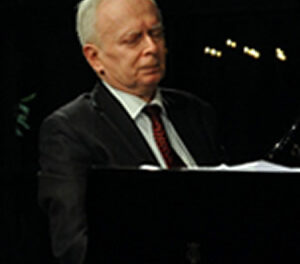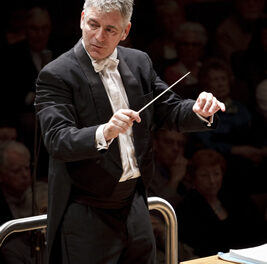The Scott Concert Hall of Porter Center was the scene of a diverse program on February 29, featuring Marilyn Keiser with the Brevard College Concert Choir in the Fifth Annual Choral Masterworks Series.
The rather long program included first Keiser playing solo organ works: the Con moto maestoso from Mendelssohn’s Third Organ Sonata, Craig Phillips’* “Beside the Still Waters,” from Windows of Comfort, and “Phoenix Processional,” and Vierne’s “Carillon de Westminster.” After a brief intermission, Keiser was joined by the Brevard College Concert Choir and the Brevard High School Chorus, Brevard Davidson-River Presbyterian Church Chorus, First Baptist Church Chorus, First United Methodist Church Chorus, the Brevard Elementary Children’s Chorus, and soloists Tara Bouknight, mezzo-soprano and Philip Bouknight, baritone, all under the direction of Kristofer J. Sanchack, for Durufle’s Requiem, Op. 9.
The audience was greeted by a very large video screen set up on stage beneath the case of the Kirkpatrick-Coleman organ. Its purpose soon became clear when a video projector was fired up showing the keydesk of the organ, otherwise out of sight behind the Ruckpositiv. Sadly, the quality of the image was the low point of the evening; if you believed what you saw on the screen, this was the night of the living dead.
The presence of the screen raises all kinds of speculations. There is an apocryphal story about Beethoven, who, when asked the meaning of the sonata he had just played, sat down and played it through again without verbal comment. What is the meaning of a concert? What is music for? If music is played in the forest and we cannot see the performer, is it still music? According to her remarks, Keiser has had neurological problems, corrective surgery, still has some swelling in her fingers, and by our witness, wears a cervical collar when she plays. The video camera allowed us to see her donning and doffing her collar between every piece. It also allowed us to see the repeated difficulty that Keiser had with her long slinky full skirt. We were able to see her repeated efforts to pull her skirt up so that she could see her feet and the pedals, and we were given repeated sightings of her upper thighs. If we can see the organist’s thighs in the forest, is it still music?
But to the music, and music it was! The Con moto maestoso is a barn-burner, the sort of high-powered stuff that kept Londoners in St. Paul’s long after Evensong was over whenever Mendelssohn played. Keiser delivered a thoroughly high-powered rendition, well-suited to my taste and to the resources of the excellent organ. The loss of the high frequencies in this otherwise fine acoustic suggests to me that a slightly more detached style of playing might be even more high powered. I suppose the high frequencies are either still bouncing around the fly-loft, or have escaped through the roof by now; they chose not to come to the concert. Keiser plays with complete self-assurance and delightful skill. I would have been quite happy if this evening had consisted entirely of Keiser playing Mendelssohn sonatas!
The two pieces by Craig Phillips, new to me, were totally dissimilar. If all I knew about Phillips was from hearing “Beside the Still Waters,” I would write him off in a heartbeat. This piece mutters and mumbles, repeating itself with a tiresome slow dementia; it never burbles and gurgles, nor does it sparkle, nor show any idiomatic organ writing. But the “Phoenix Processional,” a marching passacaglia, puts Phillips in the high ranks of modern organ composers. The thrumming, drumming, and very melodic bass theme, fun in itself, is then greatly enriched with a number of different treatments.
Vierne’s well-known “Carillon de Westminster” got accurate, careful, and fresh treatment from Keiser, and when she finished, the crowd went wild with bravos and whistles, bringing her back for three bows. After her bows, Keiser disappeared from the gallery railing and could be seen in the shadows on the video screen. The audience fell completely silent, eager for an encore; the silence prevailed until Keiser announced gently that the audience should go take a well-deserved break.
During intermission the screen was removed and the risers adjusted. Onto the stage filed the massed choruses: the program lists 144 names for chorus members, plus two soloists and seven directors and accompanists! Though there were about three females for every male singer, the balance was excellent; I never felt a need for a larger male chorus, even in the a capella double chorus parts. All of the choruses were well prepared; the young voices of the high school and college singers prevailed, giving an excellent timbre. Sadly, nowhere on the program were any of the groups credited; the names I have given above came from the college’s website.
Even with all these voices, Scott Hall is a hungry room, and the chorus was never too much. The full chorus was particularly effective in the Hosanna. There was a light show involving the organ facade, changing with each piece. Lux aeterna began a capella with the organ, though silent, bathed in a garish red light of no natural hue. The organ soon entered, and gave us, in this one movement, the whole vocabulary of the French classical organ. Worthy of particular merit were the children, who were well prepared, well behaved, and well directed.
This concert, calling on so many different resources, was a wonderful community event, well attended and seemingly enjoyed by all. Bravos all around!
*Adding errors of commission to a number of errors of omission, the program incorrectly attributed Dan S. Locklair’s “Beside the still waters,” from Windows of Comfort, and “Phoenix Processional” to Craig Phillips. Thus “Locklair” may be substituted for “Phillips” in the indicated paragraph and in three places in the 6th, as well. (CVNC thanks an attentive reader for bringing this to our attention.)













